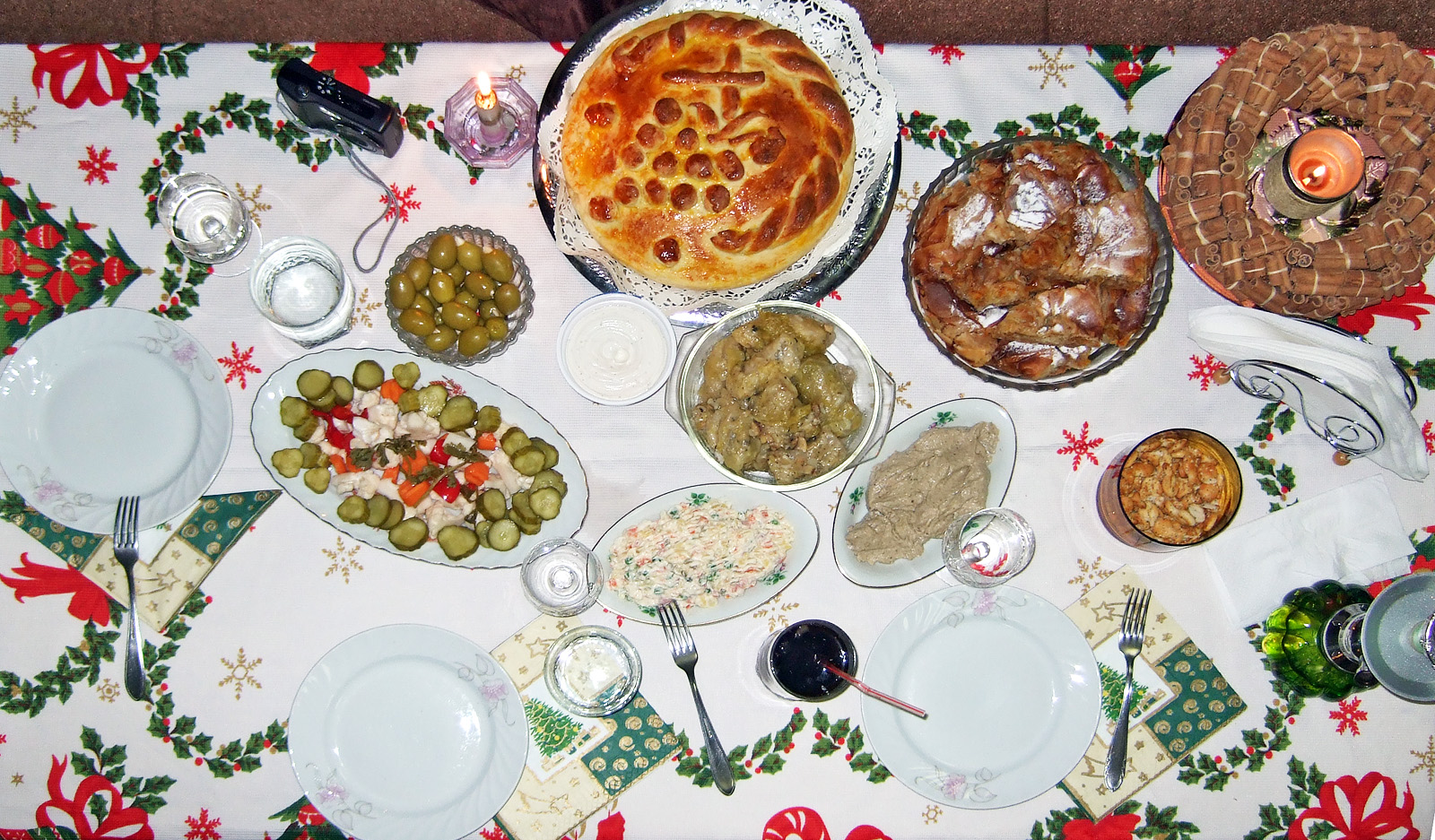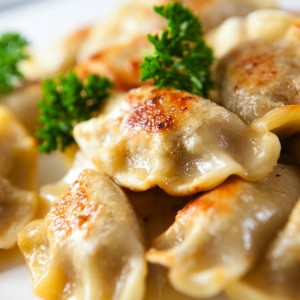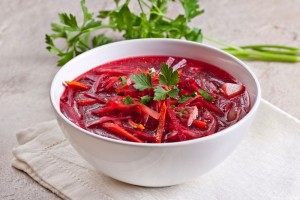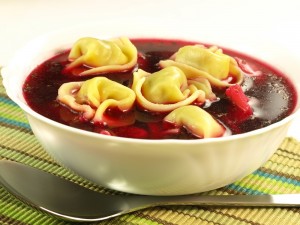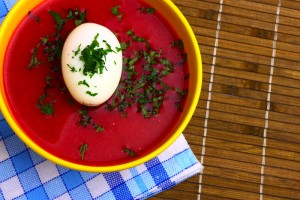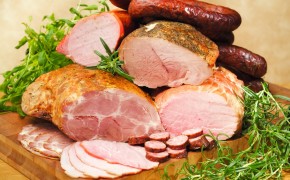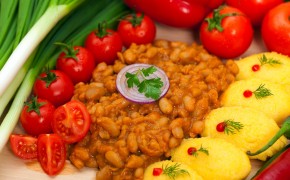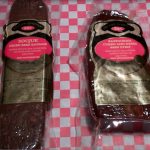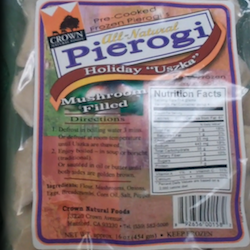
Sausage and Baleron Made in Sokołów
Sausage and Baleron Made in Sokołów
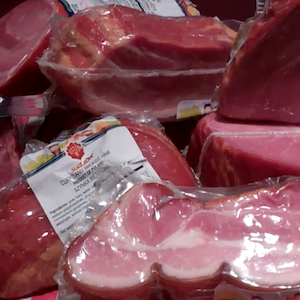
Bulgarian Food
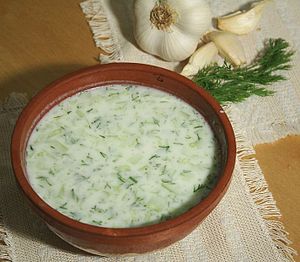
Tarator is a chilled yogurt and cucumber soup and is popular in the summer months (Photo credit: Wikipedia)
Bulgaria is a county located in southern Europe. People have lived in the area that is now Bulgaria since pre-historic times. Up until the 18th century, there was not much difference between Bulgarian food and European food. Perhaps this was due to the fact that food was scarce and people ate what they could find. Whatever the reason, Bulgarians began to develop a unique cuisine during the latter part of the 18th century.
Today, Bulgarian food remains unique although some cuisine developed in the area is enjoyed worldwide. Yogurt is one Bulgarian dish that is enjoyed all over the world. Generally, yogurt is made using cow’s milk. However, it can be made using milk from sheep, goats, or buffalo. In fact, yogurt made from these types of milk has a better flavor than yogurt made using cow’s milk. In Bulgaria, parents feed yogurt to infants at around 3 months of age. People generally eat yogurt each day even into old age. Some joke that Bulgarians only stop eating yogurt when they die.
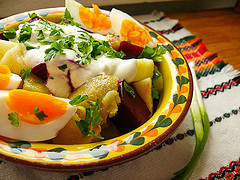
Winter Salad (Bulgarian cuisine) (Photo credit: joana hard)Bulgarians also love cheese. The two types of Bulgarian cheese unique to the region are feta cheese and yellow cheese. Feta cheese made from cow’s milk is called cow feta while cheese made from sheep milk is called sheep feta. Typically, cow feta is used as an ingredient in recipes
Bulgarian feta cheese is sold in specialty shops in the United States. It can also be ordered online. Yellow cheese is usually eaten with crackers or along with a meal.
Different areas in Bulgaria have different types of cooking styles and different types of dishes are popular. Some of the regional favorites include:
* Bansko-style kapama which is a stew made from meat and potatoes that is served in an earthenware container
* Rhodope-style cheverme which is lamb roasted over an open fire
* Thracian katmi which is a Bulgarian pancake
* Loukanka or flat sausages
Guests at local restaurants can expect tasty oven fresh bread and flavorful regional wines along with their meals. For dessert, coffee is usually served along with jam, honey, pancakes and delicate pastries called baklava.
Unlike other cultures, Bulgarian recipes use a lot of vegetables. Typically, recipes include cabbage, peppers, zucchini, garlic and mushrooms. Bulgarian dishes are usually seasoned with paprika, parsley and savory. Some recipes do call for the use of thyme and other herbs.
There are many different types of beverages that are unique to the Bulgarian region. These beverages include:
* Rakia, a fruity alcoholic beverage
* Mastica, a liquor made from the sap of the Mastic evergreen tree
* Menta, a sweet mint liquor that is very popular during the summer time
* Boza, a malted drink with a low alcoholic content
* Ayran, a drink made from yogurt and water
Popular wines include Mavrud, Gumza, and Muskat. In fact, Bulgaria is one of the world’s largest producers of wine.
There is another important difference between Bulgaria and other countries. Traditionally, Bulgarians eat their food out of special dishes made from clay. Other cultures in Europe and the world tend to eat food off plates. Today, this tradition is changing as many younger Bulgarians have begun to adopt the traditions from other countries. In many areas of Bulgaria, the tradition of eating out of specially made dishes is practiced only by the older generations.
Christmas Traditional Bulgarian Food
Related articles
Introduction to Hungarian Food
Among the most vital components of the Hungarian culture are foods and cooking. If you are still unfamiliar about the Hungarian culture, then note that its traditional cuisine greatly depends on a wide array of top-notch ingredients that are unique in the country including Hungarian meats, fruits, honey and seasonal vegetables. Among the most popular ingredients that you can find in this place are garlic and paprika. During the autumn season, Hungary boasts of the charming view of red paprika strings or red pepper that remain un-ground and hung on the majority of the houses with white walls.
Generally, the Hungarian cuisine includes spicy and rich sauces, sweets and stews. Also included among the most popular ingredients used in the majority of Hungarian recipes are tomatoes, lard, sour cream and fresh red and green peppers. Lard refers to the fats present in a goose and is widely used all over the country. Vegetable oils have also become among the most popular ingredients in Hungarian recipes. Hungary is also known for preparing desserts with the help of pastas. Among these desserts are noodles that contain cottage cheese and egg squares that include fried cabbage for its ingredients. Other popular desserts are sweets containing poppy seeds, sugared nuts and fruit jam or jellies.
For more than one hundred fifty years, Hungary had become part of the Turkish ruling. Because of this, a lot of experts have raised an assumption that the Turkish governance played a major part on the foods that the Hungarian prepares today. The Turkish introduced paprika to the Hungarian culture and up to the present this ingredient continues to represent the kind of cooking adopted by the country. Before this was introduced to the Hungarians, the traditional foods that they prepare include wild mushrooms, rosemary, horseradish, sage, dill and marjoram.
Hungary is also known for having a climate which is perfect for the cultivation and growing of paprika. This is the main reason why the country becomes the leading source of it. Because of the great talent of Hungarian chefs when it comes to cooking, the foods in the country were known internationally on the 20th century. However, communists rule the country during that time, thereby instantly putting an end to the popularity of the Hungarian cuisine. The ruling caused a shortage on a variety of ingredients and produce.
But the chefs in the country started to get back on its feet during the recent years by trying to change the conventional style of Hungarian cooking into an even healthier one by making sure that the recipes contain the least amount of calories and the highest level of vitamins. In their quest to create healthy dishes, the Hungarian chefs make it a point to still create authentic and delicious flavors for their recipes.
At present, the Hungarian cuisine is considered as one of the most delightful cuisines all over the world. If you decide to visit this country, then make sure that you never fail to try its different recipes including stews, hearty soups, luscious cakes, casseroles and pastries. You should not also fail to try the Hungarian wines especially the Tokay or Tokaji which is popular for being the best Hungarian drink. Trying out most of the popular foods in Hungary can definitely make your visit in the place truly memorable.
Where to Buy Polish Pierogies in San Francisco Bay Area
In European Market Deli And Cafe in Castro Valley you can buy pre-cooked frozen polish pierogies with cheese and potato (pierogi ruskie), sweet pierogies with cheese and polish pierogies with Sauerkraut and Mushroom. You can keep them frozen and then defrost in boiling water or at room temperature. Enjoy boiled, cooked at 400F for 15 min or sauteed in oil or butter until both sides are golden brown. They are made by Crow Natural Foods in Hanford.
European Bread
The days when European bread could only be enjoyed in Europe are long gone.
These days, the export of European bread to elsewhere in the world is pretty big business, and the popularity of European style bread is rapidly increasing in bakeries outside of Europe.
It has to be said that there are few smells like that of freshly baked bread to make the mouth water, and the bakeries which are found in abundance througout Europe certainly don’t disappoint.
If you ever have the oppportunity to travel to Europe, you’ll be spoilt for choice when it comes to European bread – bread rolls as soft as pillows, tangy sourdough bread with its characteristically crispy, chewy crust, sweet breads filled with nuts and fruit and glazed with sugar syrup – I guarantee you won’t be disappointed!
Here’s the lowdown on some of the breads you’ll find across the water in two countries renowned for their extensive varieties – Germany and Switzerland.
German Style Bread
Germany boasts the largest selection of breads of any country in the world. As well as around 600 types of bread, bakers will often put their own twist on a basic recipe, creating a new variety to add to the ever growing range. As well as German style breads, numerous different types of bread rolls and sweet pastries are items which are commonly found in German bakeries.
Germans takes their bread making pretty seriously. Bread, or Brot, is an important part of German cuisine, and throughout Germany, there are approximately 17,000 specialist bakeries, and 10,000 stores with in-store bakeries, all producing bread on a daily basis to meet customer demand.
Quite apart from the type of white bread which we are familiar with, Germany boasts a whole other range of breads, many of which are probably not so recognizable to us. There are too many varieties to mention them all individually, but here are some of the most popular;
Kürbiskernbrot – Dark rye bread with pumpkin seeds
Zwiebelbrot – Light wheat-rye bread with toasted onions
Vollkornbrot – Whole-grain
Mehrkornbrot – Multi-grain, usually a combinatin of wheat, rye and oats with linsee or sesame seed
Roggenbrot – Rye bread
Sonnenblumenkernbrot – Sunflower seeds in dark rye bread
Pumpernickel – Heavy, slightly sweet rye bread
Weißbrot – White bread
Toastbrot – Toast bread
Doppelweck – Double roll bread
Mohnbrötchen – Sweet poppy seed roll
Ulmer Zuckerbrot – Ulm sugar bread, a yeast bun with sugar, rose oil and fennel seeds
So passionate are the Germans about their bread that they will often eat it at every meal.
In a German household, bread almost always features at breakfast, and it’s usually white bread (Weißbrot or Toastbrot), or rolls which are favored at this meal.
Later in the day, open sandwiches made of dark, rye bread are popular, as are snacks such as Brotzeit, Pausenbrot, Butterbrot, and Stullen.
In the evening, Abendbrot (literally translated at Evening Bread) is typically served on the table.
German style bread is more varied than that found in other areas in Europe, and they will bake bread using pretty much every possible grain there is to bake with, for example; rye, wheat, barley, oats, spelt, corn, millet, bran and rice. German style bread made with flour derived from potato starch is also very popular, and very delicious.
Whilst on the subject of German style bread, I should also mention Bavarian bread.
Bavaria is a state of Germany, located in the southeast of the country and it’s fair to say that many of the dishes you’ll find there are shared with Germany.
In fact, much of the Bavarian bread is exactly the same as that which is found in Germany, although many Bavarian bakers have adapted the ingredients here and there to create their own varieties, with some of the more popular variations containing light, medium or dark rye, with the addition of caraway, sunflower or poppy seeds.
Here are a few more types of Bavarian bread;
Bauern Brot (Farmers bread) is a popular bread in Bavaria. Similar to other breads, it contains flour, yeast, salt and water, but unlike many others, it also contains milk. This bread traditionally features a distinctive ‘criss-cross’ pattern in the top crust.
Loaves made from whole grain rye and whole grain wheat are also popular types of Bavarian bread. Most typically shaped into a long or round loaf and dusted with flour, these crusty loaves can be found all over the state.
Bavarian style dark rye bread has a dense, but moist and chewy texture, and a slightly nutty taste.
Pretzels, which have been traditionally baked in Germany for hundreds of years, are an incredibly popular bakery item in Bavaria. Both hard and soft varieties, sweet with sugar or savory with salt and caraway seeds, can be found almost everywhere.
Swiss Bread
Switzerland certainly has its fair share of breads, claiming around 300 different varieties, and in addition to those, special variations are baked for family and celebratory events, carnivals and religious holidays.
Breadmaking in Switzerland is very much a matter of local concern, with every region throughout Switzerland having its own special bread. This is due, in equal parts, to;
The local tastes
The local traditions, and
The type of grains which are found growing in the region
In times gone by, regional breads remained very much within their own regions. These days however, breads from every territory in Switzerland can now be found all over the country, although as a general rule, Swiss Germans have a tendency to steer towards the saltier, richer and darker breads than their Swiss French and Swiss Italian neighbors, who prefer the lighter, less intensely flavored varieties.
Here are some of the varieties of Swiss bread you’ll come across in regional bakeries;
Zurich : The Zurich loaf is an oval bread with slashes across the top of a golden brown crust. Very popular throughout the whole of Switzerland.
Graubünden : Brascidela or Bracciadell is the bread of this region. Made of rye and wheat four, these loaves are ring-shape, which as tradition dictates, makes it easy to hang them up to dry after baking.
Jura : A round, flattish loaf which is popular in the French-speaking regions. Decorated with the symbols of Switzerland’s youngest region, the Jura features a bishop’s crozier in one half and stripes in the other half.
Ticino : The loaf of this region is made up of smaller loaves ‘stuck’ together, which can be easily broken off as individual pieces when the bread has been baked. The loaf is baked this way because traditionally, it was considered insulting to the baker, and to the bread, to use a knife to cut it. This Swiss bread contains white flour and vegetable oil.
Valais : A close-textured rye bread, round and flat in shape with a cracked top crust and an intense flavor. Rye is used for this local bread, as it is the only cereal suited to the cold and dry climate of the region.
Vaud : A round loaf, which has the shape of a cross cut into the top crust. This allows the baked bread to be easily broken into quarters.
Two other important type of Swiss bread are Zopf and Bürli.
Zopf is a braid-shaped bread which is considered a real treat throughout the whole of Switzerland, and is served on Sundays and on special occasions such as birthdays, weddings, baptisms and other family gatherings.
Bürli is the name given to a small loaf of bread made of white flour, yeast and salt, which is fashioned from two rolls joined together, and baked it has a very crisp, brown, chewy crust.
Conclusion
There are, of course, numerous other types of European bread.
France, Italy, Spain, Denmark, Sweden, Poland, Russia and Greece are just some of the other European countries in which bread is highly regarded, and considered an essential grocery item.
There are so many different ways to enjoy bread across Europe – in Spain, dip chunks of bread into olive oil and vinegar, in France, dunk a warm, crusty baguette into a cup of creamy hot chocolate, in Sweden, savor a wonderfully spiced cinammon and cardomom bun with a steaming cup of coffee and in Ireland, spread a thickly cut slice of warm soda bread with butter.
These are pretty simple ways to try bread, but good bread doesn’t need anything fancy to make it taste great – the quality speaks for itself.
It’s true to say that European bread is amongst some of the best in the world, but if you can’t get over there to try it in person, check out local stores for imported breads, or local bakeries for European style versions.
Enjoy!
Borscht Russian Beet Soup – European Market Castro Valley
Unlike some other similar versions, Borscht Russian Beet Soup is traditionally a hearty, cold-weather soup, intended to be served very hot. (Read the story of borshch).
The Russian version of Borscht contains a veritable feast of ingredients. Along with the obligatory beets, vegetables such as onions, cabbage, carrots, celery, turnips, parsnips, celeriac and garlic, are gently cooked in a little butter, before being simmered in a flavorsome bone-made beef broth, together with tomato paste and tender pieces of beef.
Extra seasoning is provided by salt and pepper, and some versions of the Russian Borscht recipe will also call for lemon juice to be added to the pot. The soup is cooked for around an hour, at the end of which, a handful of vividly green chopped parsley is stirred through the deeply rich magenta soup.
Although the Borscht can be eaten immediately, it is best left until the following day, when the flavors have had time to develop and intensify. However, whenever the soup is served, it should be adorned with a generous spoonful of sour cream, a sprinkling of crushed garlic and a scattering of chopped parsley or chives.
Not for the faint-hearted, tradition dictates that a steaming bowl of Russian Borscht should be served with black rye bread and ice-cold vodka shots. To comply with this tradition, all diners must be served with a bowl of the soup, which incidentally, should contain sufficient ingredients to enable a spoon to stand upright in it.
Alongside the Russian Borscht, black rye bread is served, either with or without butter, and of course, the ice-cold vodka, poured from a bottle which has been kept in the freezer, and which is returned to its icy depths after each and every shot is poured.
Borscht Russian Beet Soup
In keeping with tradition, a shot of the tantalizingly ice-cold vodka should be followed by the wonderfully contrasting heat of a warming spoonful of Russian Borscht, together with a morsel of the rich, black rye bread. To follow tradition to a tee, it’s important that the vodka is served straight-up, with no ice or other ingredient to dilute it.
Although there are certain ingredients that you will always find in a Russian Borscht, as with many classic recipes, different households often have their own family variations.
For example, some cooks will prepare the soup using potatoes and/or tomatoes, others will use various herbs and spices to flavor the stock and some will serve the soup with natural yogurt instead of sour cream.
Just as a matter of interest, the first time I cooked this soup, I made the stock from scratch, which took around three hours. In addition, as most of the vegetables need to be shredded or finely chopped for the best results, it was a pretty labor-intensive process from start to finish, which almost put me off making it again.
However, it was so yummy that I did make it again, but the next couple of times, I used readymade stock or a stock cube, which hugely reduced the preparation time. OK, so I still had to take some time with the veggies, but they say that the effort you put into something is rewarded by the results you get, and I have to say that, in the case of Russian Borscht, that’s so true!
If you ever get the opportunity to try this wonderful soup, don’t pass it up. You’re bound to agree that, whichever way it’s served, Russian Borscht is absolutely delicious!
Ukrainian Borscht Recipe
Ask any Ukrainian about Borscht, and they’re likely to tell you that the only version worth its salt is Ukrainian Borscht! In fact, so highly revered is Borscht in the Ukraine, that it is their national dish, and one of which they are unashamedly proud.
However, ask ten Ukrainians how to make Ukrainian Borscht, and you probably won’t get the same answer from any of them!
The reason for this, is that there are so many variations on the basic Borscht theme, there is no exact method of preparing it. Over the years, a number of regional variations have developed – many with their own special name – and with Ukrainian women further personalizing their own recipes, it is unknown as to precisely how many different versions of Ukrainian Borscht exist today.
Much like the Borscht to be found in other part of central and eastern Europe, Ukrainian Borscht can be served cold, but more often than not, it is ladled into bowls from a large pot, steaming hot, and fit to warm the recipient to the very core.
Ukrainian Borscht With Chicken Broth
Taken from an old Slavic word for beet, “br’sch”, or Borscht, is essentially an earthy, unpretentious, home-cooked meal. Ukrainian cuisine is well-known for the large number of ingredients in its dishes, and Ukrainian Borscht is no exception.
Either made with a vegetable or meat-based stock, this thick and wholesome soup can contain pork (which is most traditional in the Ukraine), sausage, chicken or beef, together with beets, potatoes, carrots, a selection of whatever beans are available, e.g.; runner beans, broad beans, green beans, white beans, etc., cabbage, celery, mushrooms, tomatoes, fresh herbs and garlic. Of course, if preferred, the meat can be omitted completely for an equally tasty vegetarian version.
Because of the diversity of ingredients, it’s important to ensure that when cooking Ukrainian Borscht, the beans, vegetables and meat are added to the stock in order of which takes longest to cook, to prevent the finished dish from containing a mixture of perfectly cooked, undercooked and overcooked ingredients. As time consuming as it can be, cutting everything into small, similar sized pieces is the best way to avoid this.
Vegan Ukrainian Borscht
In the Ukraine, the following accompaniments are traditionally served alongside a bowl of Borscht;
Pampushki – delicious tiny bread buns which are tossed in garlic infused oil whilst they are still warm
Smetana – an wonderfully tangy sour cream, and
Chopped chives, parsley or dill to scatter on top of the soup
In my opinion, Ukrainian Borscht is best enjoyed with plenty of freshly ground black pepper, a handful of freshly chopped chives (yes, I know it’s a lot, but I love their flavor in this!), and a generous dollop of cold sour cream swirled into the steaming hot soup – I haven’t been able to get hold of Smetana, but I’m told that regular sour cream is pretty similar.
However, I have made the Pampushki, which were surprisingly easy and totally amazing – just perfect for dunking!
When people talk about food tasting better the next day, it certainly is the case with Ukrainian Borscht, so if you make too much to finish, put it into your refrigerator in an airtight container and it’ll keep for up to three days.
Give it a try if you can – as a first course, or a main meal, Ukrainian Borscht is a sure-fire winner!
Ukrainian Borscht Recipe
- 1.5 – 2 pounds of beef or pork with bone
- 0.5 cup dry beans 1 medium beet root
- 0.5 cabbage
- 4 potatoes
- 3 carrots
- 2 onions
- 2 parsley roots
- 2-3 bay leaves
- 2-3 table spoons tomato paste
- 2 green peppers
- 5-6 black peppercorns
- 1 garlic
- 0.15 – 0.25 lb salted salo
How to cook Ukrainian borscht
- Soak dry beans for 2-3 hours.
- Cut the meat into pieces (and place them in a pot filled with cold water. Bring to a boil and skim off any fat on the surface. In 30 minutes add the soaked beans, cover and cook for about 1 hour.
- While the meat is cooking, chop the beet as thin as you can. Place the beet slices into a frying pan with sunflower or vegetable oil and fry until soft (but be careful not to make it too soft!). You can add 1 tea spoon of vinegar to save beet color if you’d like.
- Chop the cabbage (also trying to make the slices thin), peel and chop the potatoes and just leave them alone for now.
- Chop 3 carrots, 2 onions and 2 parsley roots. Fry them until the onion is becoming golden.
- Now the fun part of the borscht recipe. Time to put it all together to make a master piece. But be patient, just focus on one step at a time.
When the meat is ready add some salt, your 2-3 bay leaves, peppercorns and potatoes. - In 5-10 minutes add your fried carrots, onions, parsley roots and beets. Also add the chopped cabbage. Now slow cook for about 10 minutes.
Add 2-3 table spoons of tomato paste, wait until it boils. Now add a little bit of sugar if it is too sour for you. Turn off the stove, but your borscht is not ready yet. - Cut the salted salo into tiny cubes. Chop the head of garlic and the dill. Grind them together in a deep bowl with a wooden spoon and throw it into the cooked borscht. Wait for 10-15 minutes more, even if you find it hard to resist all of those delicious smells.
- Add a table spoon of sour cream in your soup bowl; sprinkle with a little bit of chopped parsley and dill.
Related articles
Polish Red Borscht Recipe (Barszcz Czerwony)
Polish Red Borscht
Polish red beet borscht (or barszcz) is, as the name suggests, a Polish soup made from red beets. However, the traditional Polish recipe for the soup also contains a number of additional ingredients, amongst them, beet greens, garlic, onions, carrots, celery and root parsley.
Polish red borscht is typically a vegetarian dish which is made by preparing the ingredients, and then cooking them together in water or stock to produce a clear, well-flavored, broth. In the most basic variation, all the vegetables in the Polish Red beet Borscht are removed after cooking, as they are only used for flavoring. This vivid red broth is then use for further flavorings with a little sugar, salt, freshly ground black pepper, smashed garlic, couple of drops of chili sauce vinegar or lemon juice to enhance the flavor.
Another much-loved version of Polish red beet borscht is that which is served with ‘Uszka’, which are tiny, filled, dumplings. The stuffing for the Uszka can be made from meat or vegetables, but at Christmas, a vegetarian version is traditionally prepared for the Christmas Eve supper. When served this way, the broth should be crystal clear and rich in color, with the unmistakable flavor of the beets very much in evidence.
A similar, but at the same time, very different, version of Polish red beet borscht is to serve it as above, but omit the Uszka and serve with ‘Krokiety’ instead. Krokiety are croquettes made from pancakes, which are stuffed with either minced meat, cabbage or mushrooms, together with a mixture of onions, garlic, herbs and seasoning, before being coated in egg and breadcrumbs and fried until crisp. The Krokiety can then be added to the soup, or eaten alongside it.
For something a little more luxurious, Polish red beet borscht with sour cream is a real winner! The basic soup is the same as before, but with the addition of sour cream, it becomes smooth, silky and even more delicious. This creamy version is made even more so if you swirl another spoon of sour cream into it before eating. As I do! Another variation which is favored by many, is the addition of vinegar or lemon juice to give the soup a little acidity. Many years ago, this acidity was produced by allowing the soup to naturally ferment over a period of days, and whilst this method is still used by some traditionalists, it’s a lot quicker to add acid to achieve this effect.
Finally, one of my favorite borscht variations, is that which includes bacon. Not only does it impart a wonderful smokiness to the finished soup, but it gives it a whole new dimension of flavor – absolutely delicious! Once you get the taste of Polish red beet borscht, you’ll be hooked, and no doubt, you’ll want to try every version of it you can find. Bear in mind that as this soup can be prepared hot or cold, it may be served to you chilled to perfection – in fact, this is a particularly refreshing way to enjoy the soup during the hot, summer months. Alternatively, you may see menus offering steaming bowls of hot borscht served over potatoes, beans or hard-boiled eggs.
It’s true to say that Polish red beet borscht is not to everyone’s liking, but love it or hate it, there’s no denying that it’s earned its place as a much-loved, culinary classic!
You’ll find variations of borscht in different parts of the world – all using similar ingredients, but with quite differing results. However, in Poland, the most commonly found variations of red beet borscht are as follows; The basic broth ingredients are prepared, with meat and a combination of various other vegetables added to them. This produces a much richer and heartier version of the soup, as all the ingredients are left in the broth, and everything is eaten together. Very often, a soup like this will be served as the main course of the afternoon meal in Polish households, which is known as the ‘Obiad’. Learn more about variations of Red Borscht.
 Cracow Sausage
Cracow Sausage